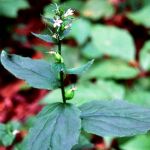| Common Name: |
Indian Tobacco |
| Other Names: |
Asthma weed, Pukeweed |
| Botanical Name: |
Lobelia inflata |
| Genus: |
Lobelia |
| Family: |
Campanulaceae |
| Native Location: |
Eastern and Central N America |
| Cultivation: |
Rich, moist soil in sun or partial shade. Lobelia inflata prefers slightly acid soil. |
| Propagation: |
By division in spring (perennials); by seed sown at 13-18°C (55-64°F); annuals in late winter, perennials as soon as ripe. |
| Harvest: |
Whole plants are cut when flowering. (L. inflata when lower fruits are ripe); used fresh or dried in decoctions (L. chinensis), infusions, liquid extracts, and tinctures. |
| Warning: |
Harmful if eater. Skin irritant and allergen.
This herb and its alkaloids are subject to legal restrictions in some countries. |
| Height: |
20-60cm (8-24in) |
| Width: |
10-30cm (4-12in) |
| Hardiness: |
Hardy |
| Parts Used: |
Whole plant |
| Properties: |
An acrid, emetic herb that stimulates respiration, increases perspiration rate, reduces inflammation, and is expectorant. |
| Medicinal Uses: |
Internally for asthma, bronchitis, whooping cough, and pleurisy. Excess causes nausea, vomiting, drowsiness, and respiratory failure. Not given to pregnant women or patients with heart complaints. Externally for pleurisy, rheumatism, tennis elbow, whiplash injuries, boils, and ulcers. For use by qualified practioners only. |
| Economic Uses: |
An important ingredient of commercial anti-smoking tobaccos (imitating effects of nicotine) and cough mixtures. |
| Bibliography: |
Encyclopedia of Herbs by Deni Brown Copyright © 1995, 2001 Dorling Kindersley Limited. Pp. 265-266 |

